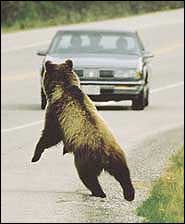Along the Road...

Be Alert

Hundreds of large mammals are killed on roadways in the mountain national parks. These accidents often result in injuries to the driver and/or passengers. Roadways attract wildlife because they provide easy travel and roadside forage. To prevent collisions with wildlife:
- Be alert. Use quick glances to scan ahead for animal movements or shining eyes.
- If you spot one animal, look for others. Animals often travel in groups.
- Improve visibility. Keep your windshield and headlights clean.
- Stay within posted speed limits. Slow down when entering snowsheds or tunnels – wildlife may be inside.

Be extra cautious at sunrise and sunset. Animals are most active at these times of day.
"Animal Jams"

Visitors are often unintentionally responsible for the death of roadside wildlife. If people get too close, animals can react aggressively. When public safety is threatened, wildlife may have to be destroyed. If you come across a traffic jam caused by roadside wildlife:
- Slow down. You have more reaction time when you travel slowly.
- Be aware of traffic, both in front of and behind you.
- Watch the road. Both wildlife and people, particularly children, may suddenly run onto the road.
- Keep moving. Accept that in heavy traffic situations, your passengers may get a quick look, but you may not. When travelling along the Trans- Canada Highway, stop only for emergencies.
- Pull over onto the road shoulder only if it is safe to do so. Never stop in the middle of the road, close to a hill, curve, or tunnel, or in heavy traffic. Do not drive off the hardened road surface.
- Remain in your vehicle, safe from both wildlife and traffic. Then move on after a few moments.
- Date modified :